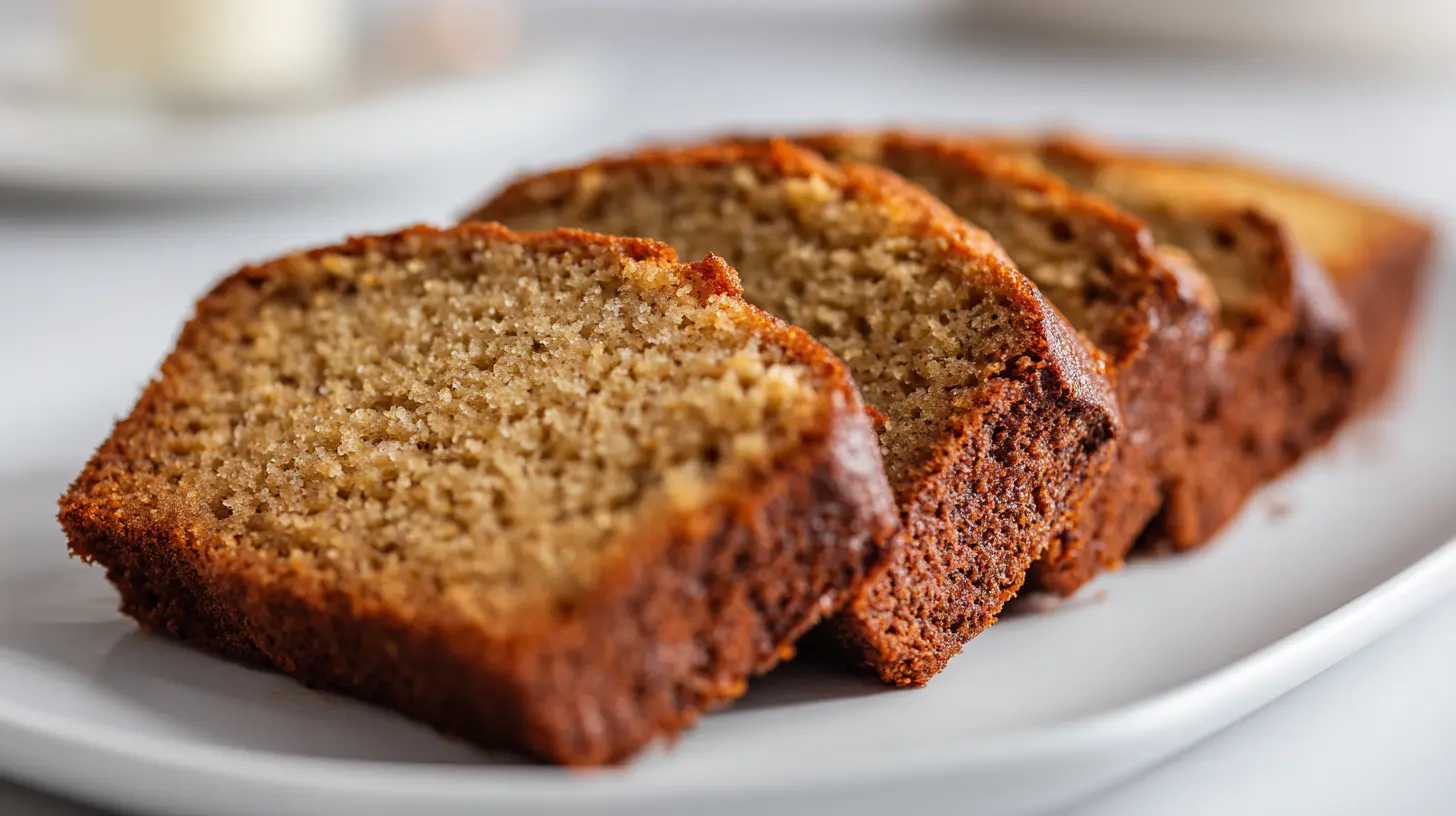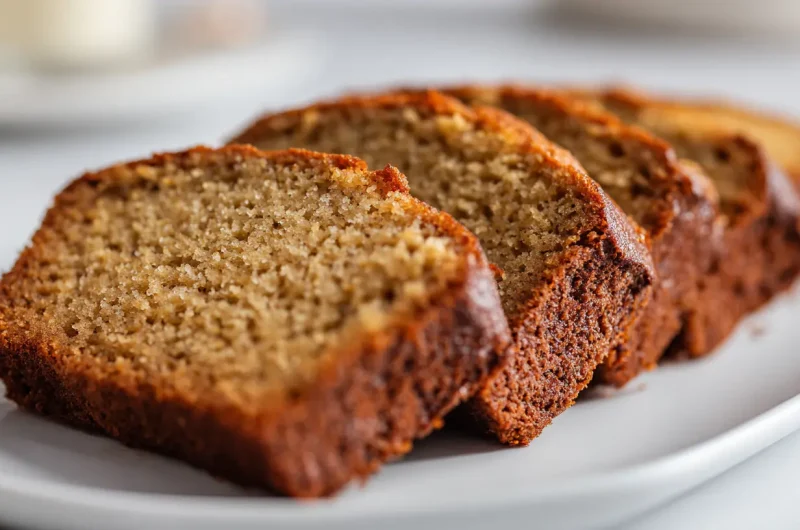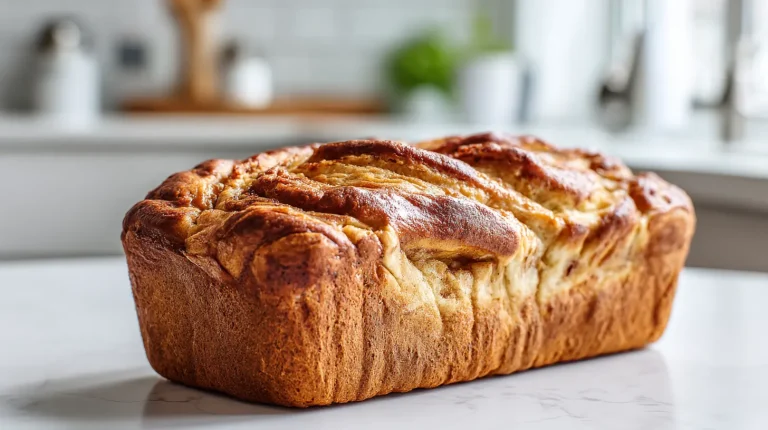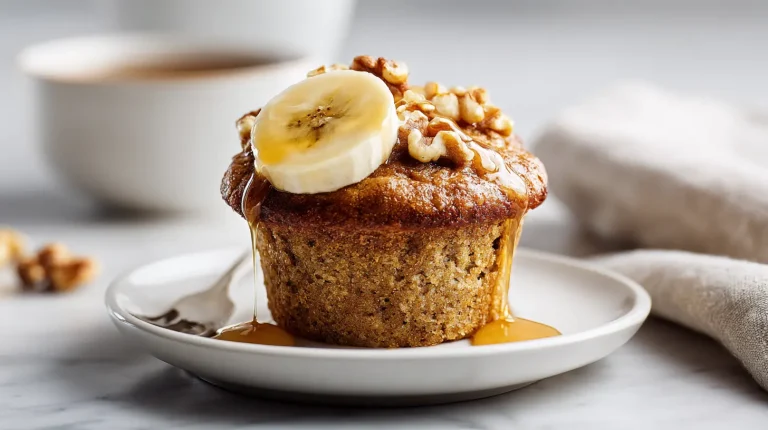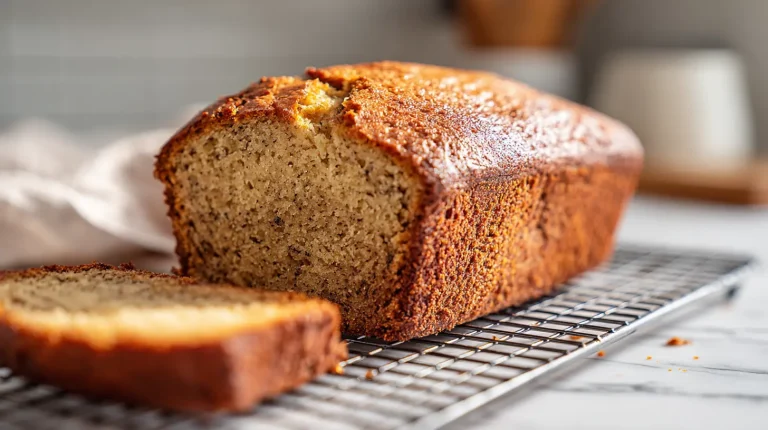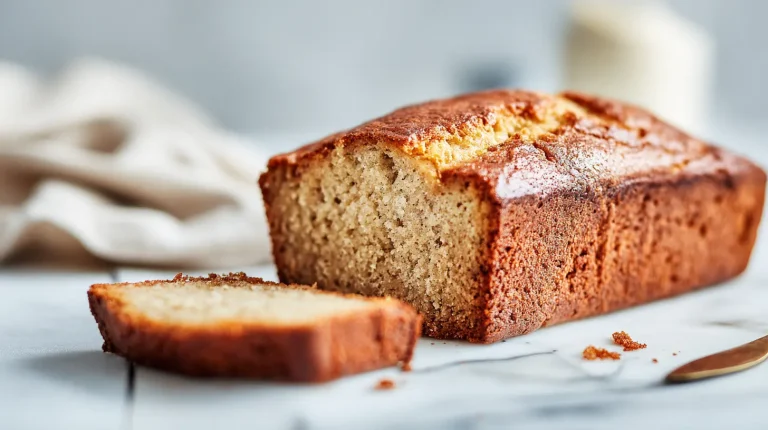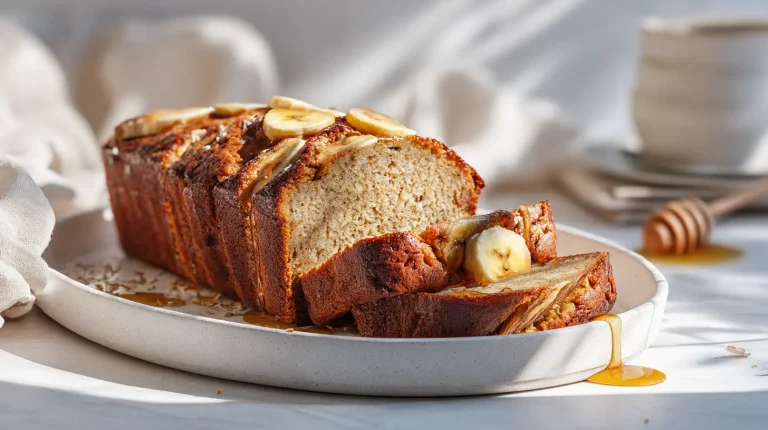Oat Flour Banana Bread – Moist Healthy Banana Oat Loaf
Oat Flour Banana Bread
Oat flour banana bread is one of those recipes that feels familiar yet completely new. It gives you the comfort of classic banana bread but with a deeper, nuttier flavor from the oats. When you grind oats into flour, they develop a naturally sweet, mild taste that pairs incredibly well with ripe bananas. The crumb becomes tender, moist, and slightly hearty without feeling dense. This version delivers all the warmth you expect from a fresh loaf but with the benefit of whole-grain flavor and a texture that stays soft for days.
People love this oat flour banana bread because it feels nourishing and satisfying. It balances comfort and nutrition in one slice, and it makes your kitchen smell like a professional bakery. It fits beautifully into everyday routines, whether you eat it warm with a pat of butter, toast it for breakfast, or pack it as a wholesome snack. This recipe also works wonderfully for those who enjoy experimenting with alternative flours. Oats are naturally light and blend seamlessly with bananas, making this loaf ideal for anyone wanting a dependable, delicious bake that never disappoints.
Many readers also enjoy this recipe because it connects to several popular styles of banana bread including moist banana oatmeal bread, oat and banana bread, banana oat bread recipe healthy versions, and banana bread made with oats. It leans toward a wholesome feel without losing the indulgent qualities people associate with banana bread. Whether you bake often or only occasionally, this is the kind of recipe that earns a permanent place in your kitchen.
Why You’ll Love This Recipe
You will appreciate this oat flour banana bread because it combines the flavor profile that home bakers love with techniques that professionals rely on. Oat flour produces an incredibly tender crumb because it naturally retains moisture. This means your loaf stays soft even on day three without becoming sticky or heavy. The bananas add body, sweetness, and richness, but the oats balance them with a clean, earthy note that rounds each bite.
A key reason this recipe works so well is the careful ratio of wet to dry ingredients. Oat flour absorbs liquid differently than wheat flour, so scaling the ingredients correctly ensures the loaf rises evenly and cooks through without leaving a gummy center. This recipe has been tested multiple times to guarantee that the texture remains consistent every time.

Another detail you will enjoy is the mixing method. By understanding how bananas break down, you will achieve a naturally smooth batter with no tough bits or dry pockets. Even new bakers can produce an even, bakery-style crumb by following the steps precisely. The method also enhances flavor because the bananas caramelize slightly during baking, creating a deeper sweetness similar to what you find in oatmeal banana bread no eggs varieties or easy banana oatmeal bread recipes.
In short, this recipe delivers consistent results, a tender structure, a balanced flavor, and a reliable rise. It is simple enough for everyday baking yet professional enough to satisfy experienced cooks.
Preparation and Cooking Time, also serving
Ingredients
Substitution Notes

Step by Step Instructions

Step 1: Mix the dry ingredients
As a chef, the foundation of a great banana bread starts with uniform dry ingredients. Place the oat flour in a large bowl and whisk it with the baking soda, baking powder, salt, and cinnamon. Whisking rather than stirring distributes the leaveners evenly so the loaf rises in a uniform dome and bakes consistently from edge to center.

Step 2: Mash the bananas properly
Use a mixing bowl and mash the bananas until they resemble a smooth puree with only a few soft lumps. Proper mashing affects the final crumb. If the banana pieces are too large, the loaf may rise unevenly. If mashed too aggressively with a blender, it becomes watery. A fork or potato masher gives the right texture.

Step 3: Combine the wet ingredients
Whisk the eggs in a bowl until lightly frothy. Add the mashed bananas, melted butter or oil, milk, brown sugar, and vanilla. Mix until the ingredients blend smoothly. This step hydrates the sugar and gives the loaf a rich color once baked. When the wet mixture is cohesive, the oat flour absorbs it more evenly during mixing.

Step 4: Bring the batter together
Pour the wet mixture into the dry ingredients. Use a rubber spatula to fold the batter gently. Folding prevents overmixing, which can create a dense or gummy loaf. Stop folding once no streaks of dry flour remain. Oat flour thickens the longer it sits, so move directly to the next step.

Step 5: Prepare the loaf pan
Lightly grease a standard loaf pan and line it with parchment paper. This ensures clean edges and helps the loaf lift out without tearing. Smooth the batter into the pan and tap it lightly on the counter to release trapped air bubbles that may cause tunnels inside the loaf.

Step 6: Bake to perfection
Bake the loaf at 350 degrees Fahrenheit for 50 to 60 minutes. Begin checking at the 50 minute mark. Insert a toothpick into the center. It should come out mostly clean with a few moist crumbs. Banana bread continues to cook slightly after it leaves the oven, so avoid waiting until the toothpick is completely dry.

Step 7: Cool before slicing
Let the loaf cool in the pan for 10 minutes, then lift it out and transfer it to a wire rack. Cooling allows the oat flour structure to firm up. If sliced too early, the steam inside the crumb can cause it to collapse or smear.
How to Serve
You can slice this oat flour banana bread while warm for a tender, aromatic treat. It pairs beautifully with salted butter, honey, almond butter, or soft cream cheese. For a breakfast style serving, toast a slice lightly and top it with a drizzle of maple syrup.
If you want a café style presentation, cut thick slices and serve with a small bowl of yogurt and fresh berries on the side. A light dusting of cinnamon or a drizzle of warm peanut butter complements the nutty taste of the oats. For an elegant dessert, plate a warm slice with vanilla ice cream or a spoonful of caramel sauce.
This loaf also works well in meal prep. You can slice it into even portions, wrap them individually, and pack them for school, work, or travel. It performs well in both sweet and wholesome meal settings.

Additional Tips
Recipe Variations
Freezing and Storage
Nutritional Information
Approximate values per slice based on ten servings.
These values vary based on ingredient choices and optional add ins.
Final Words
Baking oat flour banana bread at home gives you the chance to master a recipe that feels comforting yet refined. The method is simple enough for beginners but still offers room for creativity and learning. Each step builds flavor and structure, allowing you to understand how ingredients work together in a way that goes beyond basic baking.
Once you make this loaf, you will notice how naturally oat flour and bananas complement each other. The bread stays tender for days and always tastes wholesome and satisfying. Whether you enjoy it for breakfast or as a midday snack, it adds warmth and ease to your kitchen routine.
Keep this recipe in your rotation whenever you have ripe bananas on the counter. It is dependable, flavorful, and consistently rewarding, making it the kind of bake that becomes a household favorite.
FAQ’s
Oat Flour Banana Bread – Moist Healthy Banana Oat Loaf
Course: Bread Recipes10
servings15
minutes50
minutes220
kcalIngredients
2 cups oat flour
3 large overripe bananas mashed
2 large eggs room temperature
1 half cup light brown sugar packed
1 third cup melted butter or neutral oil
1 half cup milk of choice
1 teaspoon vanilla extract
1 teaspoon baking soda
1 teaspoon baking powder
1 half teaspoon fine salt
1 teaspoon ground cinnamon
Directions
- As a chef, the foundation of a great banana bread starts with uniform dry ingredients. Place the oat flour in a large bowl and whisk it with the baking soda, baking powder, salt, and cinnamon. Whisking rather than stirring distributes the leaveners evenly so the loaf rises in a uniform dome and bakes consistently from edge to center.
- Use a mixing bowl and mash the bananas until they resemble a smooth puree with only a few soft lumps. Proper mashing affects the final crumb. If the banana pieces are too large, the loaf may rise unevenly. If mashed too aggressively with a blender, it becomes watery. A fork or potato masher gives the right texture.
- Whisk the eggs in a bowl until lightly frothy. Add the mashed bananas, melted butter or oil, milk, brown sugar, and vanilla. Mix until the ingredients blend smoothly. This step hydrates the sugar and gives the loaf a rich color once baked. When the wet mixture is cohesive, the oat flour absorbs it more evenly during mixing.
- Pour the wet mixture into the dry ingredients. Use a rubber spatula to fold the batter gently. Folding prevents overmixing, which can create a dense or gummy loaf. Stop folding once no streaks of dry flour remain. Oat flour thickens the longer it sits, so move directly to the next step.
- Lightly grease a standard loaf pan and line it with parchment paper. This ensures clean edges and helps the loaf lift out without tearing. Smooth the batter into the pan and tap it lightly on the counter to release trapped air bubbles that may cause tunnels inside the loaf.
- Bake the loaf at 350 degrees Fahrenheit for 50 to 60 minutes. Begin checking at the 50 minute mark. Insert a toothpick into the center. It should come out mostly clean with a few moist crumbs. Banana bread continues to cook slightly after it leaves the oven, so avoid waiting until the toothpick is completely dry.
- Let the loaf cool in the pan for 10 minutes, then lift it out and transfer it to a wire rack. Cooling allows the oat flour structure to firm up. If sliced too early, the steam inside the crumb can cause it to collapse or smear.
Notes
- Ripe bananas make or break this recipe. Choose bananas with deep speckles because they carry the highest natural sugar.
- Measure the oat flour correctly by scooping lightly and leveling with a straight edge. Packed oat flour changes hydration and leads to a dense loaf.
- Keep an eye on baking time because ovens vary. A loaf baked too long becomes dry on the edges.
- If your oat flour seems coarse, sift it once to ensure a soft crumb.
- Let the batter rest for 5 minutes before baking if you want a slightly tighter texture. Oat flour absorbs moisture quickly, and this brief rest can help control spread.
- Store the loaf in the refrigerator if you live in a warm climate because bananas can spoil quickly.
- Do not slice the loaf until it has cooled enough to hold shape. Warm bread crumbles more easily.

